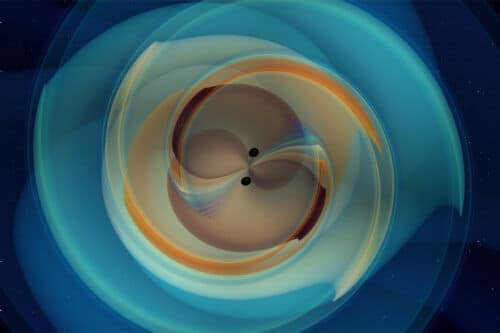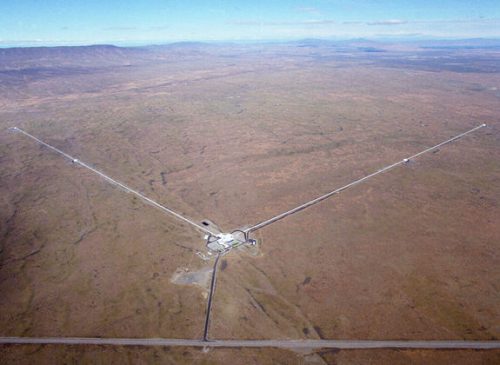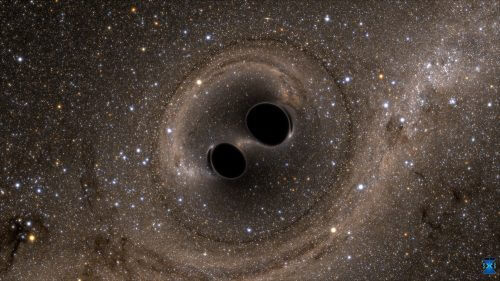A binary black hole merger probably created gravitational waves equal to the energy of eight suns * "Bang" in the Ligo and Virgo detectors is a signal for the origin of the most massive gravitational waves ever

Despite its vast emptiness, the universe bustles with activity in the form of gravitational waves. These reverberations, created by extreme astrophysical phenomena, ripple forward and vibrate the fabric of space-time, like the ringing of a cosmic bell.
Now researchers have detected a signal of what could be the most massive black hole merger ever observed in gravitational waves. The product of the merger is the first clear detection of a black hole with an "intermediate mass", which is between 100 and 1000 times that of the Sun.
They discovered the signal, labeled GW190521, on May 21, 2019, using the National Science Foundation's Laser Interferometer Gravitational-Wave Observatory (LIGO), a pair of identical 4-km interferometers in the United States, and Virgo, a 3-km detector in Italy. .
Continuation of the signal, which is like four short oscillations, very short, less than a tenth of a second. From what the researchers understand, GW190521 was created by a source about 5 gigafarsecs away, when the universe was about half its age today, making it one of the most distant sources of gravitational waves yet discovered.
As for what produced this signal, based on a powerful set of state-of-the-art computational and modeling tools, scientists think it is highly likely that GW190521 was formed by the merger of a binary black hole with unusual properties.
Almost every confirmed signal of gravitational waves to date has been from a binary merger, between two black holes or two neutron stars. This latest merger appears to be the most massive to date, involving two black holes moving in mutual spiral orbits with masses of about 85 and 66 times that of the Sun.
The Ligo-Virgo team also measured the spin of each of the black holes and found that as the black holes orbited closer and closer, they may have spun around their axes, at angles that were not aligned with the axis of their orbits. The black holes' non-coordinated spins probably caused their orbits to move from side to side, or "whip", as the two giants spiraled toward each other.

The new signal probably marks the moment when the two black holes merged. The merger created an even more massive black hole, about 142 solar masses, and released a huge amount of energy, equivalent to about 8 solar masses, that spread throughout the universe in the form of gravitational waves.
"It's not so much like a tweet, which is what we usually detect," says Virgo team member Nelson Christensen, a researcher at the French National Institute for Scientific Research (CNRS), comparing the signal to the first time Ligo detected gravitational waves in 2015. "It's more like something that makes a "bang", and it's the strongest signal we'll see in Ligo and Virgo."
The international team of scientists, which includes the LIGO scientific collaboration and the Vigo collaboration, reported its findings in two articles published today. One, appearing in Physical Review Letters, details the discovery, and the other, in The Astrophysical Journal Letters, discusses the signal's physical properties and astrophysical implications.
"Ligo surprises us again not only with the discovery of black holes of sizes that are difficult to explain, but also by doing so using techniques not specifically designed for stellar mergers," says Pedro Meronti, Director of the Gravitational Physics Program at the National Science Foundation. "This is of enormous importance because it shows the instrument's ability to detect signals from completely unexpected astrophysical events. Lego shows that he can also expect the unexpected."

in the mass gap
The uniquely large masses of the two mutually spiraling black holes, as well as the final black hole, raise many questions about their formation.
All black holes observed to date fit into one of two categories: stellar black holes, which range in size from a few solar masses to tens of solar masses and are thought to form when massive stars die, or supermassive black holes, such as the one at the center of the Milky Way galaxy, which are hundreds of thousands to several times larger billions of our sun.
But the final 142-solar-mass black hole created by the merger GW190521 is in the intermediate range of masses between stellar and supermassive black holes—the first of its kind ever discovered.
The two progenitor black holes that formed the final black hole also appear unique in their size. They are so massive that scientists suspect that one or both of them may not have formed from a collapsing star, as most stellar black holes do.
According to the physics of stellar evolution, outward pressure from photons and gas in a star's core supports it against gravity pushing inward, so the star is stable, like the Sun. After the core of a massive star fuses nuclei as heavy as iron, it can no longer generate enough pressure to support the outer layers. When this outward pressure is less than gravity, the star collapses from its own weight, in an explosion called a core-collapse supernova, which can leave behind a black hole.
This process could explain how stars as massive as 130 solar masses can form black holes of up to 65 solar masses. But for heavier stars, a phenomenon called "pair instability" is thought to be at work. When the photons of the core become extremely energetic, they can become a pair of electron and antielectron (positron). These pairs create less pressure than photons, and this makes the star unstable against gravitational collapse, and the resulting explosion is so powerful that nothing is left behind. Even more massive stars, over 200 solar masses, will eventually collapse directly into a black hole of at least 120 solar masses. A collapsing star, therefore, should not create a black hole between about 65 and 120 solar masses—a region called the "pair instability mass gap."
But now, the heavier of the two black holes that produced the signal GW190521, at 85 solar masses, is the first to date discovered within the pair instability mass gap.
"The fact that we see a black hole in this mass gap will make a lot of astrophysicists scratch their heads and try to understand how these black holes were formed," says Christensen, who is the director of the Artemis Laboratory at the Nice Observatory in France.
One of the possibilities, which the researchers raise in their second paper, is that of a hierarchical merger, where the two self-forming black holes were created by the merger of two smaller black holes, before migrating together and eventually merging.
"This event raises more questions than it provides," says LIGO team member Alan Weinstein, a professor of physics at Caltech. "In terms of discovery and physics, it's a very exciting thing."
"something unexpected"
Many questions remain about GW190521.
As the LIGO and Virgo detectors listen for gravitational waves passing through Earth, automated searches scan the incoming data for interesting signals. These searches use two different methods: algorithms that find specific waveforms in the data that may have been created by compact binaries, and more general "burst" searches, which actually look for anything out of the ordinary.
LIGO team member Salvatore Vitale, a professor of physics at MIT, compares searching for compact binaries to "running a comb through the data, which will catch things at a certain distance," compared to searching for bursts, which is more of a "catch everything" approach.
In the case of GW190521, it was a burst search that found the signal a little more clearly, opening up the very small possibility that the gravitational waves were due to something other than a binary merger.
"The bar for claiming that we found something new is very high," says Weinstein. "That's why we usually apply Occam's razor: the simpler solution is the better, and in this case it's a binary black hole."
But what if something entirely new created these gravitational waves? It's a tantalizing possibility, and in their paper the scientists briefly discuss other sources in the universe that might have produced the signal they detected. For example, perhaps the gravitational waves were emitted by a collapsing star in our galaxy. The signal could also be from a cosmic string formed just after the universe expanded in its earliest moments—although neither of these exotic possibilities fit the data as well as a binary merger.
"Since we started LIGO, all we've seen with confidence has been colliding black holes or neutron stars," Weinstein says. "This is the only event where our analysis allows for the possibility that this event is not such a collision. Although it is appropriate that this event originates from the merger of an unusually massive black hole, and alternative explanations are discounted, it pushes the limits of our confidence. And so it is potentially very exciting. Because we were all hoping for something new, something unexpected, that could change what we had already learned. This event has the potential to do that."
This research was funded by the US National Science Foundation.
to the notice of the researchers
More of the topic in Hayadan:

8 תגובות
alignment of course...
alignment in a straight line (alignment)
Spin
I got lost in non-bullshit spinners..
I can think of several other fundamental concepts in the neural universe that, although not related to Newton Einstein or Teller, also in which the letter T plays a central role.
A question I could not find an answer to. Is a black hole static or does it have a life of its own in the sense that it moves in space.
To discuss the ambiguous subject known as "gravitational waves" the question must be answered
Why does an orange fall in accelerated motion, when you let go of it?
And the answer is simple - because this is how the law of conservation of energy is fulfilled.
Lift a stone to the top of a tower, invest an amount of energy.
When he lets go of the stone, it moves in an accelerated downward motion,
And the force of its impact on the ground represents exactly the amount of energy that was needed to lift it to the top of the tower.
If the stone were to fall at a constant speed, the law of conservation of energy would not hold.
And who moves the stone in an accelerated downward motion? The stone itself
propels itself in an accelerated movement downwards, because this is how an important law of nature is fulfilled, which is the law of conservation of energy.
There are laws of nature in physical reality, and one of the most important laws is the law of conservation of energy.
The Newtonian theory states that a mysterious force emanating from a ball in the earth, is the one that drops the stone in an accelerated downward motion.
If the theory is indeed correct, then the earth is an energy provider.
And if a ball in Israel is an energy supplier? How does the law of conservation of energy apply?
Conclusion: It is possible to give up the explanation that uses gravity, and settle for the explanation that the law of conservation of energy must exist.
And if this is the case - then there is no gravity and no gravitational waves.
Indeed, there can be many explanations for the same phenomenon, and a universe operating without gravity can be presented.
The two fundamental concepts in the Newtonian universe are matter and force
The two fundamental concepts in the Einsteinian universe are matter and energy
The two fundamental concepts in the neural universe are passive time and energy.
http://img2.timg.co.il/forums/2/7512af65-e1e5-47ac-af36-b3654d2d790b.pdf
A. Asbar
From a bull?
If a brain works on electric current and there is an effect between electromagnetic radiation and electric current - then reasonable
Because mobile phones and antennas make people think wrong? Violence for example...